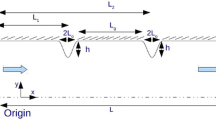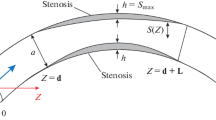Abstract
The pulsatile blood flows in solid blood vessels are investigated numerically in order to understand some physiological phenomena in arteries. For the geometry of the blood vessels, one-point stenosed and periodically stenosed blood vessels are considered. Taking advantage of axisymmetry in the problem, the stream function-vorticity formulation is used for the governing equations of the fluid flows. All the computations are performed by using the ADI scheme of the finite difference method on the numerically generated boundary-fitted orthogonal curvilinear coordinate systems. The flow fields are found to be dramatically different depending on the Strouhal number. When the Strouhal number is 0(1) or larger, the flow field is quite dynamic in the sense that the vortices formed during the previous period survive and exert residual stress on the blood vessel wall. On the other hand, when the Strouhal number is as small as 0(10-2), the flow fields are found to be in the quasi-steady state. The computation results suggest that the deterioration of endothelial cells may occur due to strong local flow fields near the stenosis and that the probability of platelet attachment to the blood vessel wall is higher in the region behind the stenosis. From the results for the periodically stenosed vessel, the so-called steady streaming phenomenon is confirmed. The steady streaming effect in a wavy channel is expected to increase the heat and mass transfer rate without making the flow turbulent.
Similar content being viewed by others
References
Batchelor, G. K., “An Introduction to Fluid Dynamics”, Cambridge University Press, Cambridge, 1967.
Daly, B.J., “A Numerical Study of Pulsatile Flow through Stenosed Canine Femoral Arteries”,J. Biomechanics,9, 465 (1976).
Dinnar, U., “Cardiovascular Fluid Dynamics”, CRC Press, Inc. U.S.A., 1981.
Dragon, C. A. and Grotberg, J. B., “Oscillatory Flow and Mass Transport in a Flexible Tube”,J. Fluid Mechanics,231, 135(1991).
Dutta, A., Wang, D. M. and Tarbell, J. M., “Numerical Analysis of Flow in an Elastic Artery Model”,ASME Journal of Biomechanical Engineering,114, 26(1992).
Flaherty, J.T., Pierce, J. E., Ferraus, V.J., Patel, D. J., Tucker, W. K. and Fry, D. L., “Endothelial Nuclear Patterns in the Canine Arterial Tree with Particular Reference to Hemodynamic Events”,Circulation Research,30, 23 (1972).
Fung, Y. C., “Biodynamics-Circulation”, Springer-Verlag, New York, 1984.
Kaneko, A. and Honji, H., “Double Structures of Steady Streaming in the Oscillatory Viscous Flow over a Wavy Wall”,J. Fluid Mechanics,93, 727(1979).
Kang, I. S. and Leal, L. G., “Numerical Solution of Axisymmetric, Unsteady Free-Boundary Problems at Finite Reynolds Number. 1. Finite Difference Scheme and Its Application to the Deformation of a Bubble in a Uniaxial Straining Flow”,Phys. Fluids,30, 1929(1987).
Leal, L. G., “Laminar Flow and Convective Transport Process”, Butterworth-Heinemann, Boston, 1992.
Ling, S. C. and Atabek, H. B., “A Nonlinear Analysis of Pulsatile Flow in Arteries”,J. Fluid Mechanics,55, 493(1972).
Ma, X., Lee, G. C. and Wu, S. G., “Numerical Simulation for the Propagating of Nonlinear Pulsatile Waves in Arteries”,ASME Journal of Biomechanical Engineering,114, 490(1992).
Nishimura, T., “Oscillatory Viscous Flow in Symmetric Wavy-Walled Channels”,Chemical Engineering Science,44, 2137(1989).
Oh, H. J. and Kang, I. S., “A Non-Iterative Scheme for Orthogonal Grid Generation with Control Function and Specified Boundary Correspondence on Three Sides”,J. Comput. Phys.,112, 138 (1994).
Patel, D. J. and Vaishnav, R. N., “Basic Hemodynamics and Its Role in Disease Processes”, University Park Press, Baltimore, 1980.
Pedley, T. J., “The Fluid Mechanics of Large Blood Vessels”, Cambridge University Press., Cambridge, 1980.
Savvides, C. N. and Gerrard, J. H., “Numerical Analysis of the Flow through a Corrugated Tube with Application to Arterial Protheses”,J. Fluid Mechanics,138, 129(1984).
Sobey, I. J., “On Flow through Furrowed Channels”,J. Fluid Mechanics,96, 1 (1980).
Sobey, I. J., “Oscillatory Flows at Intermediate Strouhal Number in Axisymmetric Channels”,J. Fluid Mechanics,134, 247 (1983).
Tutty, O. R., “Pulsatile Flow in a Constricted Channel”,ASME Journal of Biomechanical Engineering,114, 50 (1992).
Wang, D. M. and Tarbell, J. M., “Nonlinear Analysis of Flow in an Elastic Tube (Artery): Steady Streaming Effects”,J. Fluid Mechanics,239, 341 (1992).
Womersley, J. R., “Method for the Calculation of Velocity, Rate of Flow and Viscous Drag in Arteries When the Pressure Gra-, dient Is Known”,Phil. Mag.,46, 199 (1955).
Wu, S. G., Lee, G. C. and Tseng, N. T., “Nonlinear Elastic Analysis of Blood Vessels”,ASME Journal of Biomechanical Engineering,106, 376 (1984).
Author information
Authors and Affiliations
Rights and permissions
About this article
Cite this article
Jeong, Y., Kang, I.S. Pulsatile flows in stenosed blood vessels. Korean J. Chem. Eng. 12, 540–550 (1995). https://doi.org/10.1007/BF02705857
Received:
Accepted:
Issue Date:
DOI: https://doi.org/10.1007/BF02705857




